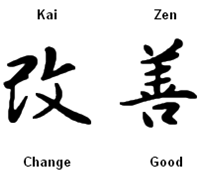Using Kaizen for Employee Engagement and Improvement
Tanmay Vora

Kaizen is a Japanese term that means continuous improvement. It all sounds good on the surface, but the reality is that very few companies fully embrace kaizen. They say, “But we’re improving all the time.” That may be true, but it’s the way in which companies make improvements that matters.
In companies that truly embrace kaizen, the bulk of improvement—from surfacing problems and opportunities, to designing, testing, and implementing countermeasures (a better word than “solutions”)—are done by the people who do the work. In most organizations, however, improvements are “mandated” by supervisors, managers, and senior leaders. This organizational behavior has several key consequences:
1) The people doing the work become numb order-takers versus engaged problem solvers.
2) The improvement is often merely a “change,” not true improvement.
3) The improvement is resisted because it’s being forced on people who had no involvement in designing it.
In my book, The Outstanding Organization, I show how kaizen is a highly effective means to boost employee engagement by meeting three basic human needs: 1) The need to connect, 2) the need to be creative, and 3) the need to be in control. This last one often scares leaders; they fear they’ll lose control and anarchy will occur. But, in properly executed kaizen, the frontlines are given control within clearly defined boundaries that leadership themselves set.
There are two ways to approach kaizen. Ultimately you want improvement being designed and implemented by everyone, every day, everywhere in an organization.This transformation requires both leadership development and a disciplined problem-solving and improvement process. Kaizen events, highly structured improvement activities that are an effective shaping tool, are a second way to shift culture and begin reaping the significant benefits from achieving both high levels of employee engagement and rapid results.
In both cases, employees have ample opportunities to connect with organization purpose, a specific problem or opportunity, and each other. They use their creative potential in highly fulfilling ways. And they are given the level of control that all human beings need and deserve. In a word: they become deeply ENGAGED.
The people who do the work are the experts, not leaders nor consultants. If you want employees to engage, you must create the conditions for engagement to occur. Creating a proper kaizen culture is the way to achieve this. Start today!
– – – – –
 Today’s Guest Post comes from Karen Martin – author of The Outstanding Organization, which addresses the missing fundamentals that are key success factors in organizational transformation. Karen is the founder of Karen Martin & Associates and she is also the co-author of The Kaizen Event Planner: Achieving Rapid Improvement in Office, Service, and Technical Environments
Today’s Guest Post comes from Karen Martin – author of The Outstanding Organization, which addresses the missing fundamentals that are key success factors in organizational transformation. Karen is the founder of Karen Martin & Associates and she is also the co-author of The Kaizen Event Planner: Achieving Rapid Improvement in Office, Service, and Technical Environments.
[…] outline the lessons learned. All this is only helpful when it results into a meaningful change. Kaizen complements Hansei and ensures that lessons are […]